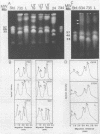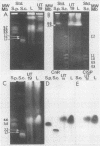Abstract
Chromosomes of the fungal respiratory pathogen, Coccidioides immitis, were separated by contour-clamped homogeneous electric field gel electrophoresis. Twelve isolates were examined, the majority of which showed four chromosomes with a range of molecular size from 11.5 to 3.2 Mb. Three isolates (C634, C735, and L) revealed three chromosomal bands under the conditions employed for electrophoretic separation. However, in two of these isolates (C634 and C735), four chromosomes were visible on membrane transfers of pulsed-field gels after Southern hybridization between the chromosomal DNA and selected DNA probes. The probes included a conserved ribosomal gene and three previously described cDNAs isolated from C. immitis expression libraries. The L isolate was determined to have the same genome size as a typical four-chromosome isolate on the basis of microspectrophotometric comparison of fluorescence intensity of the ethidium bromide-stained nuclear DNA. The genome size of C. immitis determined by microspectrophotometry was approximately 28.2 +/- 2.6 Mb. The calculated genome size based on addition of the average molecular weights of chromosomal bands separated by contour-clamped homogeneous electric field gel electrophoresis was approximately equal to the estimate derived from the spectrophotometric analyses. This is the first report of the electrophoretic karyotype of C. immitis.
Full text
PDF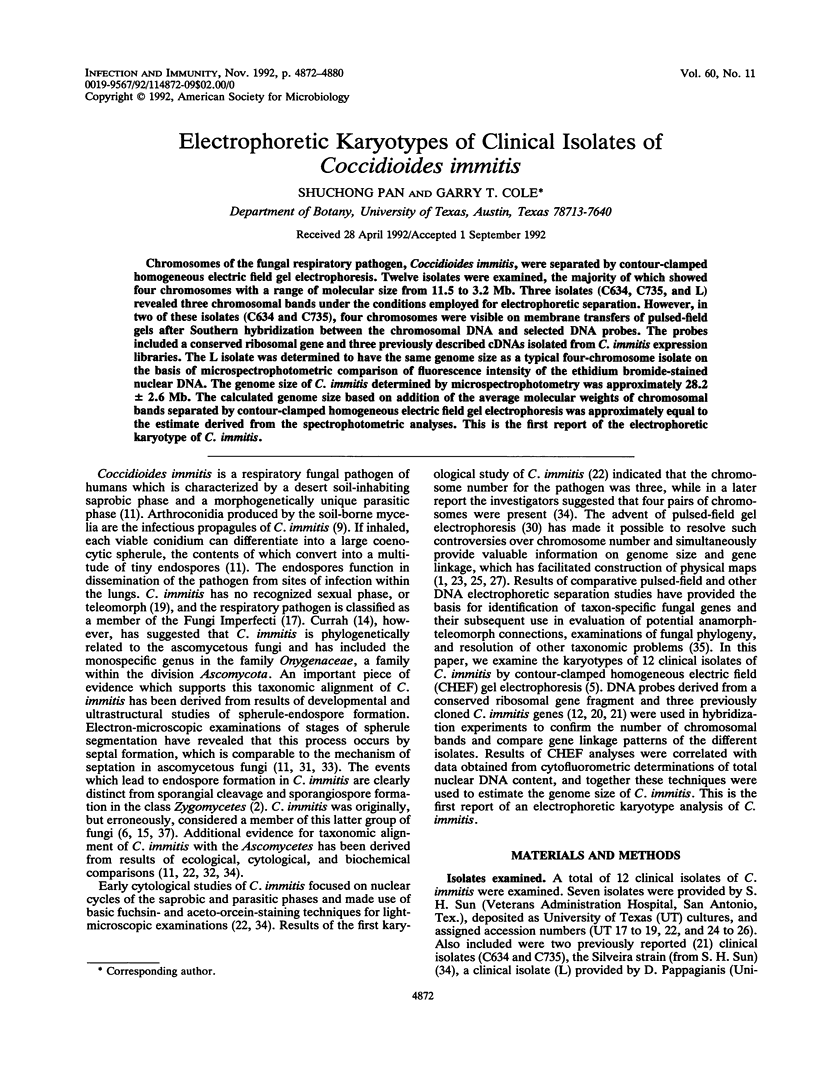

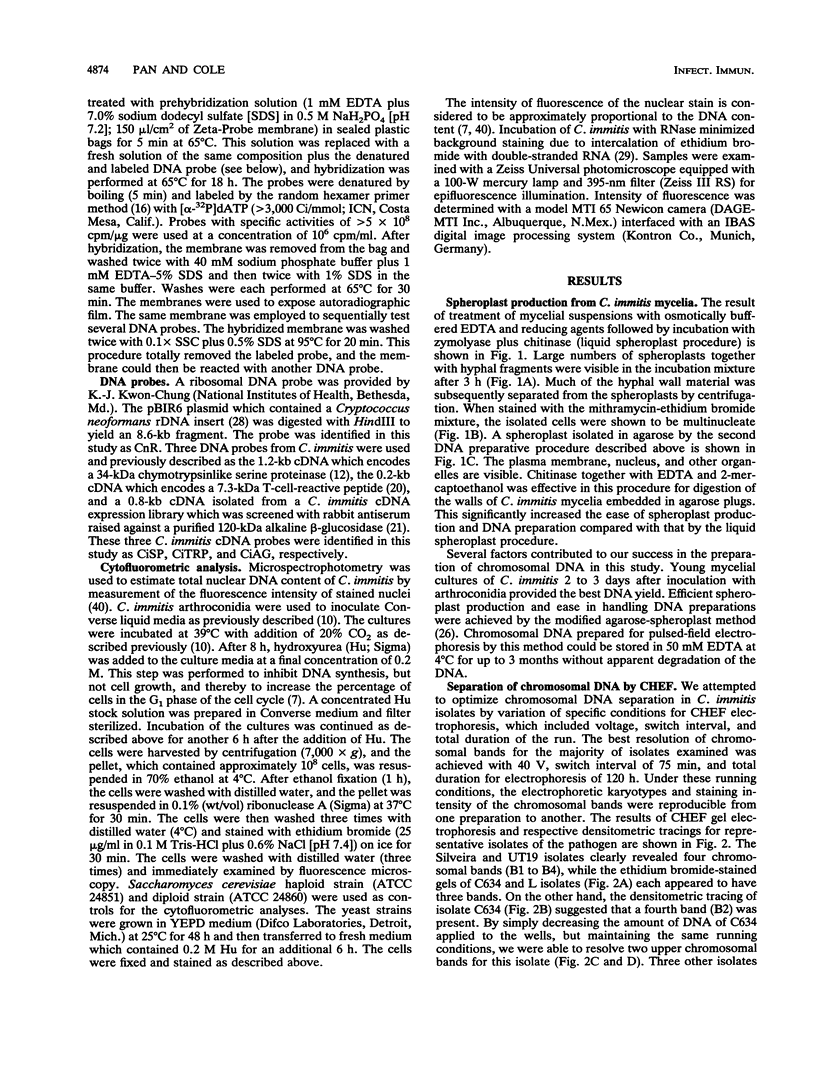
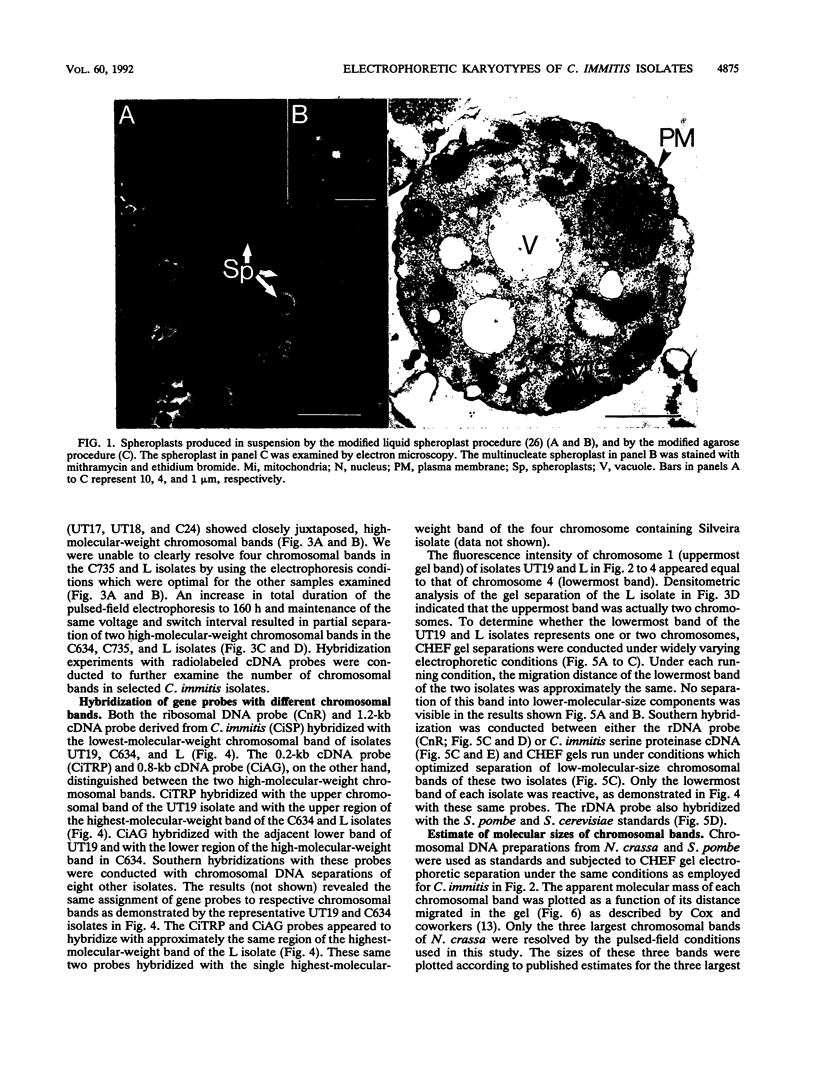
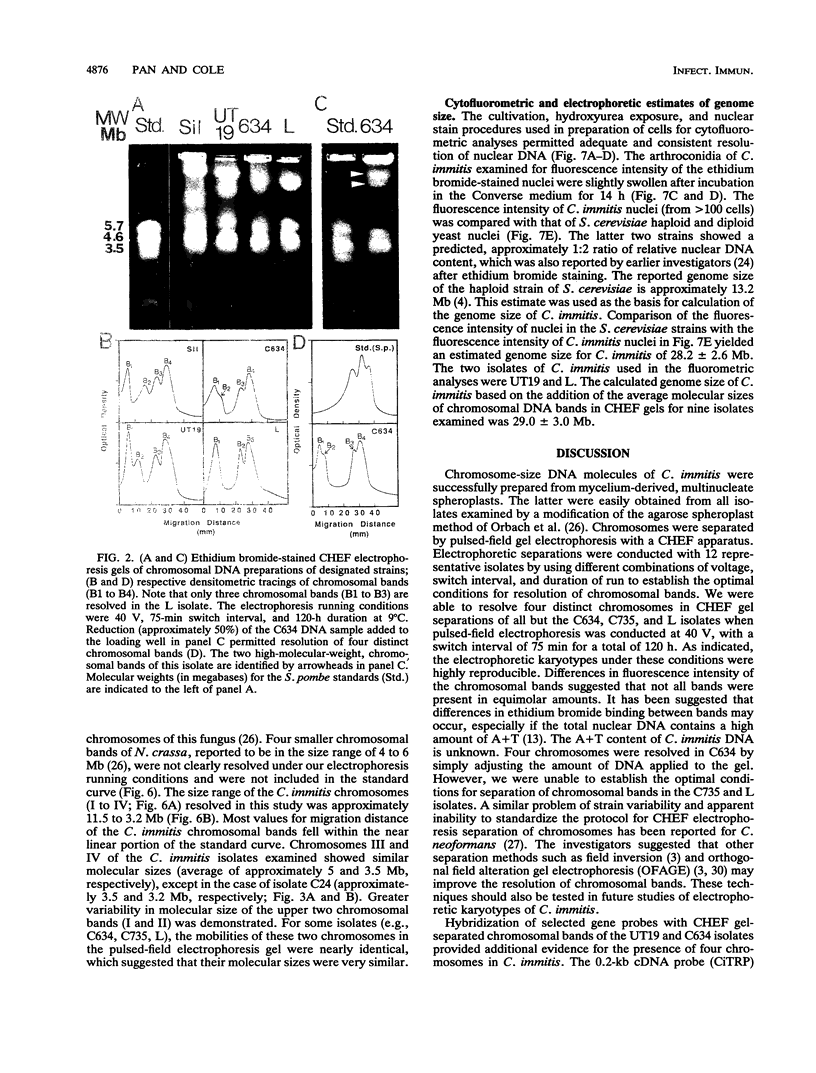
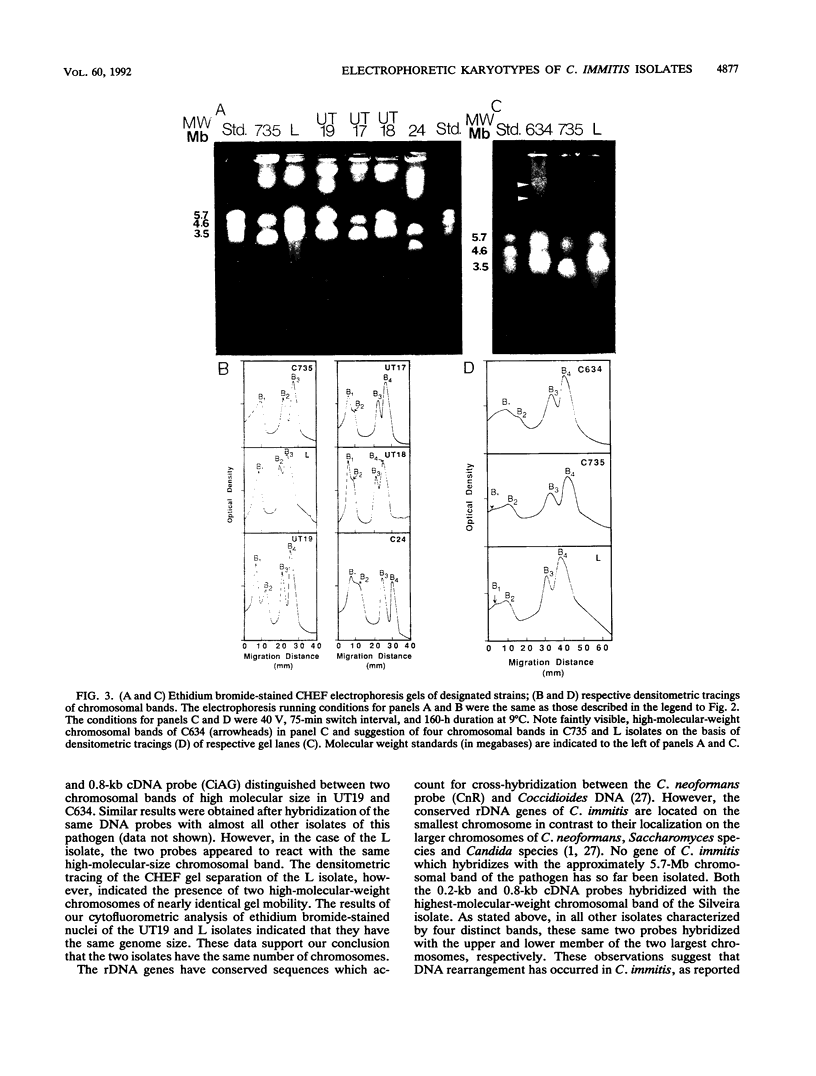
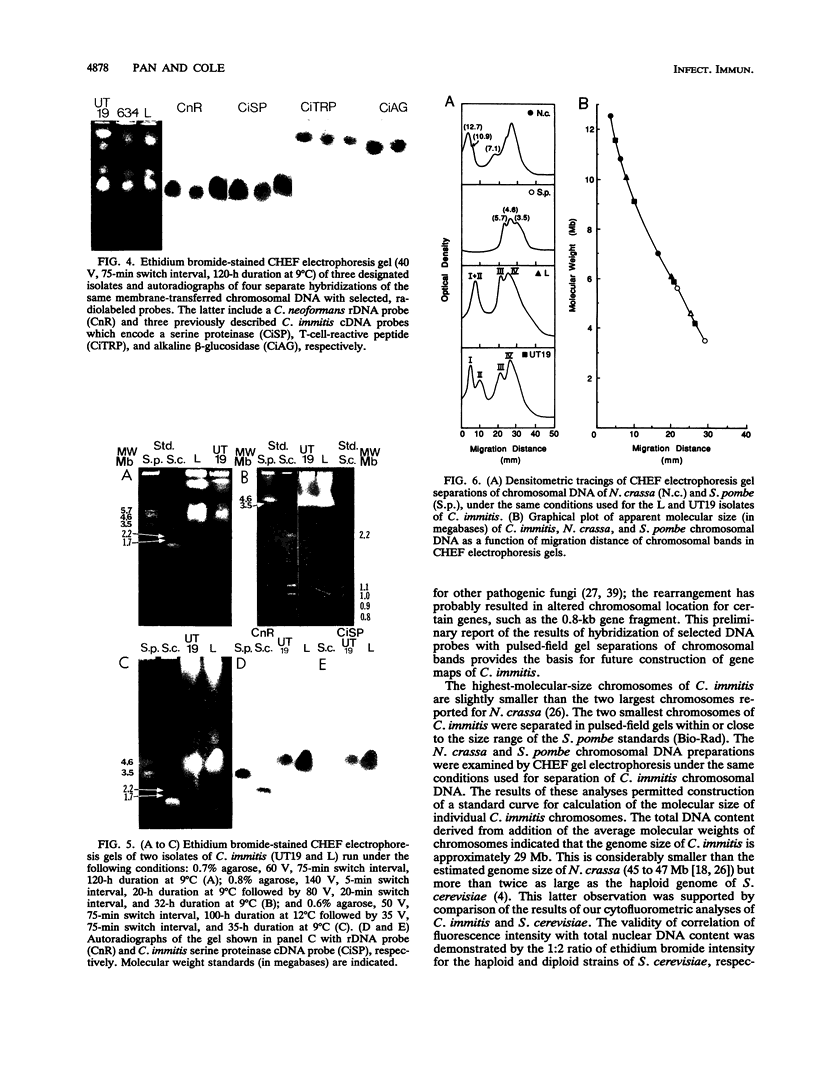
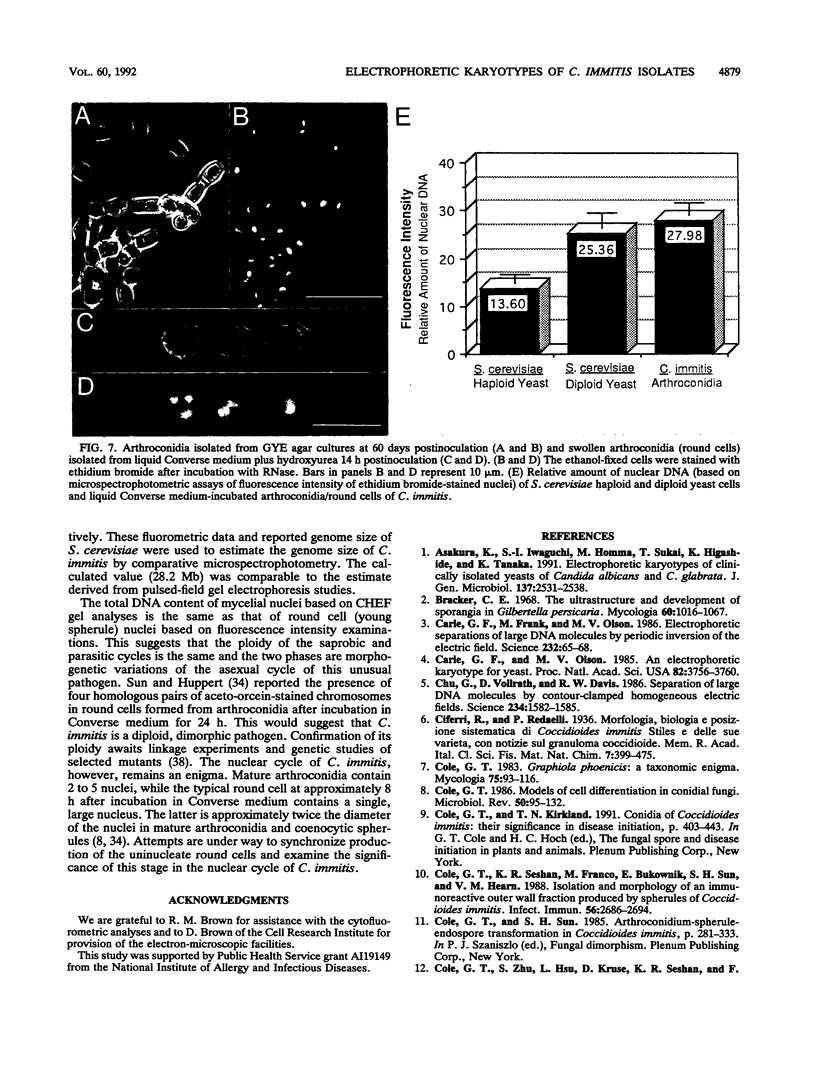

Images in this article
Selected References
These references are in PubMed. This may not be the complete list of references from this article.
- Asakura K., Iwaguchi S., Homma M., Sukai T., Higashide K., Tanaka K. Electrophoretic karyotypes of clinically isolated yeasts of Candida albicans and C. glabrata. J Gen Microbiol. 1991 Nov;137(11):2531–2538. doi: 10.1099/00221287-137-11-2531. [DOI] [PubMed] [Google Scholar]
- Bracker C. E. The ultrastructure and development of sporangia in Gilbertella persicaria. Mycologia. 1968 Sep-Oct;60(5):1016–1067. [PubMed] [Google Scholar]
- Carle G. F., Frank M., Olson M. V. Electrophoretic separations of large DNA molecules by periodic inversion of the electric field. Science. 1986 Apr 4;232(4746):65–68. doi: 10.1126/science.3952500. [DOI] [PubMed] [Google Scholar]
- Carle G. F., Olson M. V. An electrophoretic karyotype for yeast. Proc Natl Acad Sci U S A. 1985 Jun;82(11):3756–3760. doi: 10.1073/pnas.82.11.3756. [DOI] [PMC free article] [PubMed] [Google Scholar]
- Chu G., Vollrath D., Davis R. W. Separation of large DNA molecules by contour-clamped homogeneous electric fields. Science. 1986 Dec 19;234(4783):1582–1585. doi: 10.1126/science.3538420. [DOI] [PubMed] [Google Scholar]
- Cole G. T. Models of cell differentiation in conidial fungi. Microbiol Rev. 1986 Jun;50(2):95–132. doi: 10.1128/mr.50.2.95-132.1986. [DOI] [PMC free article] [PubMed] [Google Scholar]
- Cole G. T., Seshan K. R., Franco M., Bukownik E., Sun S. H., Hearn V. M. Isolation and morphology of an immunoreactive outer wall fraction produced by spherules of Coccidioides immitis. Infect Immun. 1988 Oct;56(10):2686–2694. doi: 10.1128/iai.56.10.2686-2694.1988. [DOI] [PMC free article] [PubMed] [Google Scholar]
- Cox E. C., Vocke C. D., Walter S., Gregg K. Y., Bain E. S. Electrophoretic karyotype for Dictyostelium discoideum. Proc Natl Acad Sci U S A. 1990 Nov;87(21):8247–8251. doi: 10.1073/pnas.87.21.8247. [DOI] [PMC free article] [PubMed] [Google Scholar]
- Feinberg A. P., Vogelstein B. A technique for radiolabeling DNA restriction endonuclease fragments to high specific activity. Anal Biochem. 1983 Jul 1;132(1):6–13. doi: 10.1016/0003-2697(83)90418-9. [DOI] [PubMed] [Google Scholar]
- Kirkland T. N., Zhu S. W., Kruse D., Hsu L. L., Seshan K. R., Cole G. T. Coccidioides immitis fractions which are antigenic for immune T lymphocytes. Infect Immun. 1991 Nov;59(11):3952–3961. doi: 10.1128/iai.59.11.3952-3961.1991. [DOI] [PMC free article] [PubMed] [Google Scholar]
- Kruse D., Cole G. T. A seroreactive 120-kilodalton beta-1,3-glucanase of Coccidioides immitis which may participate in spherule morphogenesis. Infect Immun. 1992 Oct;60(10):4350–4363. doi: 10.1128/iai.60.10.4350-4363.1992. [DOI] [PMC free article] [PubMed] [Google Scholar]
- Langsley G., Ponnudurai T. Plasmodium falciparum: analysis of karyotype polymorphism using chromosome-specific probes. Exp Parasitol. 1988 Apr;65(2):168–173. doi: 10.1016/0014-4894(88)90120-8. [DOI] [PubMed] [Google Scholar]
- Lauer G. D., Roberts T. M., Klotz L. C. Determination of the nuclear DNA content of Saccharomyces cerevisiae and implications for the organization of DNA in yeast chromosomes. J Mol Biol. 1977 Aug 25;114(4):507–526. doi: 10.1016/0022-2836(77)90175-9. [DOI] [PubMed] [Google Scholar]
- Mahrous M., Lott T. J., Meyer S. A., Sawant A. D., Ahearn D. G. Electrophoretic karyotyping of typical and atypical Candida albicans. J Clin Microbiol. 1990 May;28(5):876–881. doi: 10.1128/jcm.28.5.876-881.1990. [DOI] [PMC free article] [PubMed] [Google Scholar]
- Orbach M. J., Vollrath D., Davis R. W., Yanofsky C. An electrophoretic karyotype of Neurospora crassa. Mol Cell Biol. 1988 Apr;8(4):1469–1473. doi: 10.1128/mcb.8.4.1469. [DOI] [PMC free article] [PubMed] [Google Scholar]
- Perfect J. R., Magee B. B., Magee P. T. Separation of chromosomes of Cryptococcus neoformans by pulsed field gel electrophoresis. Infect Immun. 1989 Sep;57(9):2624–2627. doi: 10.1128/iai.57.9.2624-2627.1989. [DOI] [PMC free article] [PubMed] [Google Scholar]
- Restrepo B. I., Barbour A. G. Cloning of 18S and 25S rDNAs from the pathogenic fungus Cryptococcus neoformans. J Bacteriol. 1989 Oct;171(10):5596–5600. doi: 10.1128/jb.171.10.5596-5600.1989. [DOI] [PMC free article] [PubMed] [Google Scholar]
- Schwartz D. C., Cantor C. R. Separation of yeast chromosome-sized DNAs by pulsed field gradient gel electrophoresis. Cell. 1984 May;37(1):67–75. doi: 10.1016/0092-8674(84)90301-5. [DOI] [PubMed] [Google Scholar]
- Sun S. H., Huppert M. A cytological study of morphogenesis in Coccidioides immitis. Sabouraudia. 1976 Jul;14(2):185–198. [PubMed] [Google Scholar]
- Vilgalys R., Hester M. Rapid genetic identification and mapping of enzymatically amplified ribosomal DNA from several Cryptococcus species. J Bacteriol. 1990 Aug;172(8):4238–4246. doi: 10.1128/jb.172.8.4238-4246.1990. [DOI] [PMC free article] [PubMed] [Google Scholar]
- Vollrath D., Davis R. W. Resolution of DNA molecules greater than 5 megabases by contour-clamped homogeneous electric fields. Nucleic Acids Res. 1987 Oct 12;15(19):7865–7876. doi: 10.1093/nar/15.19.7865. [DOI] [PMC free article] [PubMed] [Google Scholar]
- Whelan W. L. The genetics of medically important fungi. Crit Rev Microbiol. 1987;14(2):99–170. doi: 10.3109/10408418709104437. [DOI] [PubMed] [Google Scholar]
- Wickes B. L., Golin J. E., Kwon-Chung K. J. Chromosomal rearrangement in Candida stellatoidea results in a positive effect on phenotype. Infect Immun. 1991 May;59(5):1762–1771. doi: 10.1128/iai.59.5.1762-1771.1991. [DOI] [PMC free article] [PubMed] [Google Scholar]





